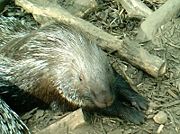Cape Porcupine
2008/9 Schools Wikipedia Selection. Related subjects: Mammals
| Cape Porcupine | ||||||||||||||||
|---|---|---|---|---|---|---|---|---|---|---|---|---|---|---|---|---|
 |
||||||||||||||||
| Conservation status | ||||||||||||||||
| Scientific classification | ||||||||||||||||
|
||||||||||||||||
| Binomial name | ||||||||||||||||
| Hystrix africaeaustralis Peters, 1852 |
The Cape Porcupine or South African Porcupine, Hystrix africaeaustralis, is a species of Old World porcupine. Contrary to its name, this porcupine species inhabits much of sub-Saharan Africa, excluding the southwestern deserts of the continent. This rodent is nocturnal and inhabits rocky outcrops and hills. They shelter in caves or dens they dig themselves. Female cape porcupines are the biggest rodents in southern Africa, weighing more than 30 kilograms (66 pounds) and growing more than two feet long. The cape porcupine is covered in bristly quills varying in thickness. The longest spines grow as long as the animal's body and quills only eight inches shorter. On its tail, the spines are hollow to make a rattling sound to scare away predators. When attacked, the porcupine freezes.If cornered, it turns vicious and charges to stab its attacker with its quills. Otherwise, the porcupine may retreat into its burrow, exposing only its quills and making it hard to dislodge.
Unlike most rodents, the cape porcupine is very long-lived. The oldest animals can be 15 to 20 years old. They are also fast to grow. Litters of four are nursed for four months and reach adult size in only a year. The cape porcupine eats mostly plant material: fruits, roots, tubers, bulbs, and bark. Special microorganisms in the animal's gut break down this tough vegetation. The porcupine has also been reported to gnaw on carrion and bones.